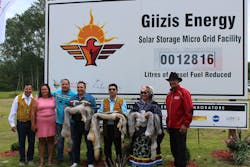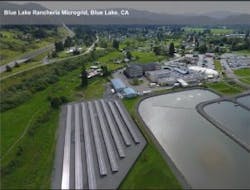What Can We Learn from Indigenous Communities about Microgrids?
In Canada, indigenous community members, developers and utilities work together to maximize the potential of microgrids to combat climate change, with indigenous communities often owning a share in the projects.
The US government, policymakers and the microgrid industry could model this approach to fight climate change and strike partnerships with indigenous communities, said Chris Henderson, executive director of Indigenous Clean Energy, a nonprofit organization that promotes collaboration with indigenous peoples for a clean energy future.
“It would be fair to describe indigenous people as the country’s strongest clean energy community,” according to the report “Accelerating Transition: Economic Impacts of Indigenous Leadership in Catalyzing the Transition to a Clean Energy Future Across Canada.”
“The real point we’re making: There is opportunity for greater collaboration in places like Hawaii,” Henderson said, noting that Hawaii’s energy mix includes 12% coal and clean microgrids could replace that. “There’s a real synergy between sharing information about how these projects can be developed. We are doing dozens of projects at a time,” he added.
In remote areas of Canada where Indigenous Clean Energy is focused on promoting clean microgrids, communities are generally supplied by diesel-based generation. The impacts and costs of diesel are high, said Henderson. Diesel can be noisy, costly and carbon emitting and costs as much as $2 per kWh, especially if the diesel is flown into the community. The average cost is 40 to 45 cents/kWh, he said.
Everyone benefits
The diesel is used in communities — especially in northern Canada — that are heavily impacted by climate change.
“The north of Canada is one of the fastest warming areas of the world and the impact is profound,” said Henderson. “This affects wildlife, fisheries and indigenous communities.”
About 50 to 55 microgrids that aim to reduce diesel use are now in development. They are owned in part by the indigenous communities. They generally incorporate solar, storage and advanced controls. Government programs such as NRCan’s Clean Energy for Rural and Remote Communities often support such projects, with an eye toward cutting rural and remote communities’ reliance on diesel fuel for heat and power.
Microgrid projects in the region include the Fort Chipewyan microgrid, which has 2.2 MW of solar and 1.5 MW of battery storage. It cuts diesel use by about 211,338 gallons per year, reduces the number of tanker trucks on the road, cuts emissions and brings community benefits through ownership of the microgrid, according to a video about the project by Three Nations Energy, which is the owner and operator. The company is an equal partnership between three Fort Chipewyan Nations — the Athabasca Chipewyan First Nation, the Mikisew Cree First Nation and the Fort Chipewyan Metis Association.
Under the project, two leaders from each of the three nations sit on the board of directors.
“This is a project that’s very successful,” said Chief Allan Adam of the Athabasca Chipewyan First Nation in the video. “Everyone benefited from it. That’s the beauty of working together.”
Henderson said that when developing such projects, it’s important to make sure the community supports them. His organization ensures there’s an “intensive consultative process” that can take place over months or years to ensure the community is behind the project. That’s important, given that indigenous communities are generally co-owners of such projects.
Encompasses more voices
“Often, decisions are consensus based, there’s a lot of information sharing,” Henderson said. “To me, it’s the right way to do it.”
This also helps ensure that women and youth are more involved in decision making. This differs from traditional processes, where large companies and utilities are the decision makers.
“We want inclusion of all people, including women and youth. We have a strong ethic toward including all members of a community,” said Henderson.
Jana Ganion, sustainability and government affairs director for Blue Lake Rancheria located in Humboldt County, California, agreed that collaboration is a key to the success of microgrid projects.
The two microgrids at Blue Lake Rancheria are also the result of collaboration among diverse groups, including Blue Lake Rancheria, the California Energy Commission (CEC), Humboldt State University, Schatz Energy Research Center and Pacific Gas & Electric. The CEC provided funding, and the university and Schatz Energy Research Center supplied technical support.
“I think certainly this approach is absolutely replicable and the benefit stack is real,” said Ganion.
Blue Lake Rancheria’s microgrid project began in 2011 after a Japanese earthquake and tsunami spurred an evacuation that took everyone by surprise. Tribal facilities were inundated by people seeking supplies and help.
“Based on that event, the tribe focused more on being prepared for those kinds of larger emergencies,” Ganion said.
California at that time was beginning to focus more on establishing clean emergency power in rural and tribal areas.
“With that kind of synergy, we were able to apply for and receive CEC funding, and the tribe kicked in the rest, and we attracted top-tier technology vendors to build a system,” said Ganion. The first microgrid was completed in 2017, and the second in 2019. Both are grid connected, include solar and batteries and are capable of islanding from the grid. One is a community microgrid; the other one fuels the gas station and a convenience store.
The decision to pursue the microgrid strategy was made by Blue Lake Rancheria’s tribal council, an elected body that governs the community. The tribe also focused on educating its members, adding a solar rooftop pilot program that raised the interest and excitement of tribal members.
Blue Lake Rancheria in Humboldt County, California, was a 2019 winner of a Microgrid Knowledge Greater Good Award. Photo courtesy of Siemens.
“With smaller populations, you can socialize these ideas much more efficiently than larger tribes with populations located pretty far from each other,” said Ganion. The education efforts are part of the tribe’s overall strategy for decarbonizing and creating resilience, she added.
The community microgrid’s resilience turned out to be critical.
After the first public safety power shutoff in the region, Blue Lake Rancheria’s microgrid came to the rescue, serving people from the community and outlying areas.
“We served the community, really the entire region, from emergency response agencies to health clinics,” said Ganion. “There were a lot of needs met during that 30-hour outage just because we had the microgrid in operation. The most intense and urgent need was for power for medical equipment.” The tribe worked with the state’s Department of Health and Human Services, powering hotel rooms to house medical equipment.
Different community members appreciate the microgrids for different reasons, including resilience, clean energy and power savings, Ganion noted.
Indigenous communities looking for partners
Clean microgrids and other forms of clean energy are not only important to indigenous people in California. In Oregon, members of the Warm Springs Reservation are eager to work with others to develop green energy projects, said Jim Manion, general manager of Warm Springs Power & Water, during a conference in early November organized by the Oregon Solar and Storage Industries Association.
“A lot of developers look at reservations and rule them out, but tribes are open for business,” Manion said. “It takes time to find solutions around [climate] challenges. Tribes have vast resources of land. We want to work with you to face the aggressive challenge in front of us.”
Microgrids built as a result of collaboration — like the efforts of Blue Lake Rancheria and Indigenous Clean Energy — need to become more common, said Henderson.
“This is an untold story about the collaboration of communities, locals, developers and utilities working together to maximize the potential of microgrids to combat climate change. A good way to do this is to look at the potential for Canada and the US to work together,” said Henderson.
Track news about microgrids for indigenous communities. Subscribe to the free Microgrid Knowledge Newsletter.
About the Author
Lisa Cohn
Contributing Editor
I focus on the West Coast and Midwest. Email me at [email protected]
I’ve been writing about energy for more than 20 years, and my stories have appeared in EnergyBiz, SNL Financial, Mother Earth News, Natural Home Magazine, Horizon Air Magazine, Oregon Business, Open Spaces, the Portland Tribune, The Oregonian, Renewable Energy World, Windpower Monthly and other publications. I’m also a former stringer for the Platts/McGraw-Hill energy publications. I began my career covering energy and environment for The Cape Cod Times, where Elisa Wood also was a reporter. I’ve received numerous writing awards from national, regional and local organizations, including Pacific Northwest Writers Association, Willamette Writers, Associated Oregon Industries, and the Voice of Youth Advocates. I first became interested in energy as a student at Wesleyan University, Middletown, Connecticut, where I helped design and build a solar house.
Twitter: @LisaECohn
Linkedin: LisaEllenCohn
Facebook: Energy Efficiency Markets


